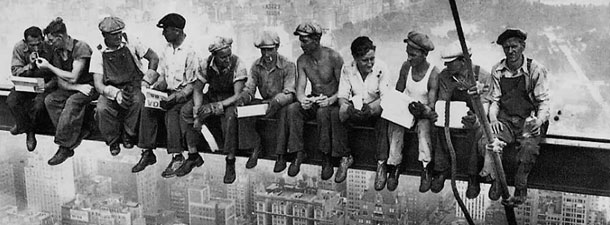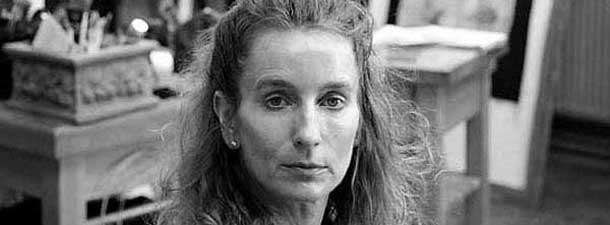
Hypocritical Window-Dressing or Brave New Corporate World?
April 30, 2012
Connecting Light and Landscape to Living Spaces
May 26, 2012Emma Sergeant, one of England’s best-known portraitists and figurative artists, burst into prominence in 1981 as a 21-year old student at the Slade School of Fine Art in London. That year she won the National Portrait Gallery Portrait Prize. The award included a commission from the gallery to paint a well-known figure – she painted two: Lord David Cecil and Lord Olivier. Bee van Zuylen interviewed Sergeant at her studio in Chelsea.
E
Emma Sergeant, one of England’s best-known portraitists and figurative artists, burst into prominence in 1981 as a 21-year old student at the Slade School of Fine Art in London. That year she won the National Portrait Gallery Portrait Prize. The award included a commission from the gallery to paint a well-known figure – she painted two: Lord David Cecil and Lord Olivier. Bee van Zuylen interviewed Sergeant at her studio in Chelsea.

Emma Sergeant
While she first became known as a portraitist, Emma Sergeant’s art has evolved since then into what she herself has described as “an alchemical form.” She has painted in various media, depicting a diverse array of subjects. These range from the Greek myth of Orpheus and Eurydice, Sumerian gods and the ancient world, representations of contemporary life, to the intrinsic bond between humans and animals, including her latest fascination: evocative paintings of horses.
Emma divides her time between Chelsea, where she lives with her husband, biographer and historian Adam Zamoyski, and Poland where the two of them are building a new home.

Emma, art today , where is it at, in your opinion?
Art’s a tricky business now because figurative art has come back in. So much money has gone into conceptual art, it’s very difficult to say that show is over because a lot of public money has gone into it. It’s not endurable.
I’ll be very fascinated to see what’s around to show for this moment, these last 20 years, and what we’ll be seeing in 200 years in the museums to represent this era. What’s around now is Left Bank stuff. It’s very Rive Gauche, and that’s great. It’s jolly, but it’s ephemeral. It’s got about as much of a life span as a dress. You wear it till you’re sick of it and you chuck it.
 |
 |
And where’s the market for art right now?
I think it’s quite an interesting moment in art right now, because what you have is all the wonderful old-fashioned galleries in Bond Street, Cork Street, New Bond Street. They’ve lost their way as far as I can see. They’re not getting the off-street trade they used to when people went out for lunch and then dropped into a gallery or two and maybe buy something. They took that for granted. And what I’ve noticed now, is that the very rich in this country are people with decorators. They do the buying, and they are the secondary agents.
What about the training for up-and-coming artists these days?
…I had amazing teachers, and I feel the young don’t have the luxury of the teachers I had. They are not taught to draw, there are not even people around, even if you want to learn to draw. Charles Gibbered and Sagimans later at Camberwell – I know what’s in my generation, a few, a handful to teach the entire country! They do still have very good teaching though, if you go to somewhere like St. Paul’s or any good public school.
 |
 |
People or animals, which gives you the more satisfaction when doing a portrait?
…My old friend Tomasz Starzewski opened up a decorating shop on Pimlico Road. He offered to do a show for me as he had got me horse commissions in the past, and I am very keen on doing horse art. Although I love doing portraits, right now I love doing animals, because with them, in a way, you don’t have the psychological fallout. They wear their souls on their sleeves, or on their hooves, as it were! Peeling away at a human being is a complex business, sometimes you feel that you’ve put your fingers into a festering wound. I never know what I’m going to find in a human being. I do warn people that I don’t know what’s going on in your life, but I’ll find it! You know what’s happening. I don’t. I tell them that if they are on Prozac or going through a divorce it’s going to show…. Sometimes you can find incredible harmony in people – in the most unexpected, severe, plain-featured people, suddenly there is an enormous amount of light. So I can only assume that it’s a soul business; it’s a great portrait when it’s the meeting of two people, not just an observation.
I love the tightrope aspect of it. It’s a balance between letting go and observation.
How did you get into painting horses specifically?
When I started drawing horses it was only for practice for drawing people – like life-drawing classes, like doing scales. I started in Sussex at a friend’s yard where I used to play polo, and after riding I would draw my two horses that were extremely tired and very cooperative. I would sneak around because I was so embarrassed that others at the yard would see me and think: but she’s a portrait painter, isn’t she?. Then they’d see me do a rubbish drawing of a horse. But one of the grooms came up and looked at my drawing and knew instantly which horse it was. She said, “You’ve really got his character.” I grew in confidence then.
What’s the process in getting that perfect horse portrait?
I started doing larger and larger drawings. It was fascinating working with animals because they know before I know when the picture is going wrong, and they stop cooperating. With an animal there seems to be a vibration coming out of me. I mentally haven’t accepted that the picture has gone wrong. I haven’t stepped back or checked the composition, and I carry on working and getting faintly frustrated, feeling the picture going dead. And meanwhile the animal is turning his back to me, and I think et en plus, this wretched creature is not cooperating!. So I step back in a rage and see that I’ve started the picture in the wrong place.
 |
 |
I usually get someone to hold them and I have to be quick. I do a huge drawing or painting in 40 minutes max if you have the right ground – oil on gesso for instance. Sometimes the background is the hardest. The horse can take 40 minutes, and then working out the highlights and the right colour can take me three or four months. And then I find that I could’ve just opened a catalogue and looked at the background of Whistlejack green behind Stubb’s horse.
I was including drawings and paintings of horses at my exhibitions at the Fine Art Society. Then I did two shows with horses, and Tomasz was getting me so many commissions. It’s the sort of work I love to do and I love drawing them from life, getting on with it, it’s all very immediate. You get so much more from the experience. I can’t understand anyone who draws from photographs! It’s inspiring working with Tomasz in his new shop. His whole presentation and ideas are inspiring and it’s all very modern looking. He has introduced me to new ideas: the paper I work on, the way we float the picture. It’s an experiment which is taking me down a new route. A client might want me to use sanguine, or another client asks me to use gold leaf, and I think why not? I’m happy to be asked to do different media. It’s interesting. I did a triptych on gold leaf (I had never done that before) of two rearing horses on long vertical panels. I did waste time getting it right – there were too many legs! I had to change it and start sculpting it, a bit like the Elgin Marbles. I suddenly realised it had a sculptural quality as I threw a lot of paint at it which is really the way I wanted my paintwork to go. I don’t see myself as a traditional painter like Sargent, I’m not a liquid painter like he is, I’m far more a linear painter, and after masses of chaos I find the form and – well, we all have our language.
You’re actually quite a romantic painter, aren’t you?
Yes, you’re right, I am! . But, strangely, I’ve suddenly bizarrely gone biblical! It must come from spending all this time in Poland…. Catholicism is coming to me! I am always looking for inspiration in a narrative, because I feel you have to cast your characters. I start the picture before I find what it’s about, so as I’m trying to work out my composition and my cast of characters. I become aware of the story, then I give it its title, and it falls into place and characters come and go. You hang on to them and you think they look exquisite and perfectly painted, then you realise the entire composition is being held back by the thing you were hanging on to! Then the character goes and he’s sort of condensed into something else. I feel it’s a very strange way of working . . ..
Where do you spend most of your time these days?
I am now spending about six months of the year in Poland where my husband comes from. We’ve been looking for a property. It’s been difficult to find the right land. You no longer have big estates. It’s mainly government owned, and it was all lost with Communism. And now it’s wonderful to see that the Poles are going back to building with wood, and stone, as that architecture was all lost.
Is there anything specifically Polish that inspires you?
Yes, I am actually going to be doing some oil sketches of trees, lovely beech trees there in Poland, using copper, wood, not bronze. I would’ve loved to sculpt, but now I think I’m too old to be a sculptor. It’s too hard on the bones. But I’m very keen on texture and depth, and glazing. My idea of glazing is just throwing a lot of turps at the picture and thinning it out! I find if I use a lot of paint it usually means it’s going wrong.
What are your plans for the future?
I’d like now to do small collections with occasionally the unveiling of a big piece. The only big exhibition I’d be interested in would be a retrospective exhibition, because I’ve been exhibiting since, well, I won the National Gallery National Portrait prize in 1981. It was a drawing I did from my imagination, which I did at art school, and it won, much to my surprise and everyone else’s! That picture only took me a year and a half! Whereas the one I just gave Tomasz, I took four years over. So it’s not like I’m speeding up with age! I’ve done a lot of other work while doing it, but I couldn’t resolve it, and like all the best pictures, it resolved itself. Sometimes if I feel it’s not going to work then I just turn it upside down and start again. My greatest work has often been when I’ve turned it upside down and started again and it’s been done in seconds.
I don’t want to paint to deadlines anymore. I don’t walk outside my world. I love what I do, not to be under pressure. I only want to do good art and that takes time. I don’t have time and I don’t like what’s going on in the art world. As far as I can see there are a lot of frightened people creating images and not art. And there’s far too much money floating around.

Who, out of the current crop of painters, do you admire right now?
Who do I admire now out there? I guess I would kill for an Auerbach drawing; he’s a fabulous draftsman. I love Emily Young, her sculptures, great stone heads of angels, which I adore. I could have a dozen of hers. Nick Johnson is an extraordinary carver. We have a piece of his, a lurcher made of wood.
Can you tell Dantemag readers what the next Emma Sargent work will be about?
My new theme is called Herod Hears the News, so I went off to draw some lions. I want him to be an old lion who’s waiting for a younger one to come and take his territory. But that’s another story!




